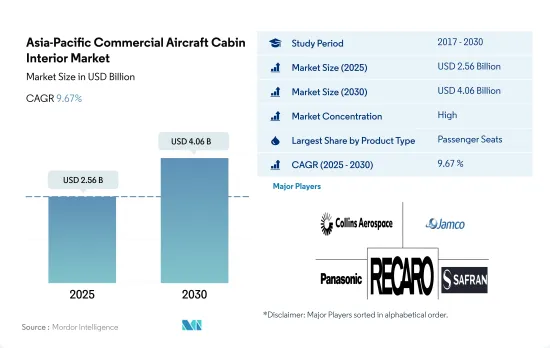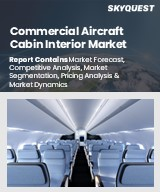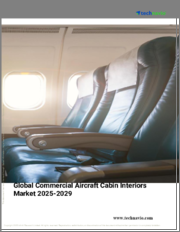
|
시장보고서
상품코드
1685962
아시아태평양의 민간항공기 객실 인테리어 : 시장 점유율 분석, 산업 동향, 성장 예측(2025-2030년)Asia-Pacific Commercial Aircraft Cabin Interior - Market Share Analysis, Industry Trends & Statistics, Growth Forecasts (2025 - 2030) |
||||||
아시아태평양의 민간항공기 객실 인테리어 시장 규모는 2025년에 25억 6,000만 달러에 달할 것으로 추정됩니다. 2030년에는 40억 6,000만 달러에 이를 것으로 예상되며, 예측 기간 중(2025-2030년)의 CAGR은 9.67%를 나타낼 것으로 전망됩니다.

갤러리, 화장실 등으로 구성된 기타 제품 유형 부문은 큰 성장이 예상됩니다.
- 아시아태평양의 민간항공기 객실 인테리어 시장은 제품 유형별로 시트, 객실 조명, 기내 엔터테인먼트 시스템, 창, 갤리, 화장실 및 기타 제품 유형으로 구분됩니다. 이 지역의 항공사는 이러한 제품의 실용성을 높이는 동시에 승객의 전반적인 편안함과 경험을 향상시키는 데 주력하고 있습니다.
- 비즈니스 클래스 이용자의 선호도가 높아지고 있기 때문에 이코노미 클래스보다 개발 공간이 넓은 좌석 구조가 필수적입니다. 아시아태평양 항공사 및 OEM은 2050년까지 탄소 배출 제로를 달성하겠다는 목표에 따라 항공기 경량화 및 항공 산업의 지속 가능한 경영 방법 개발을 위한 노력을 강화하고 있습니다.
- 이 지역의 항공사는 LED 조명으로 효율, 신뢰성, 내구성, 무게 측면에서 기존의 기내 조명의 다양한 단점을 해소할 수 있었기 때문에 첨단 LED 조명으로 전환하고 있습니다. 따라서 다양한 OEM에 의한 LED 조명의 진보는 기존 항공기 객실 조명보다 시장 성장을 가속할 것으로 예상됩니다.
- 에어 인디아, 싱가포르 항공, 중국 남방 항공과 같은 주요 항공사는 화면의 품질과 기능면에서 기내 엔터테인먼트 스크린 제품을 개선하기 위해 노력하고 있습니다. 이 지역에서는 2022년부터 2028년에 걸쳐 4,000대 이상의 여객기가 납입될 것으로 전망됩니다. 항공기 조달 수의 급증은 예측 기간 동안 여객 항공 업계에서 민간항공기 객실 인테리어 수요를 끌어올릴 것으로 예상됩니다.
중국이 민간항공기 객실 인테리어 시장을 견인해, 이 지역 시장 점유율은 48%에 달할 것으로 예상됩니다.
- 경제·인프라 개발의 진전에 의한 인구 1인당 소득 증가가 항공 여객수 증가에 기여해 국내 항공사 및 지역 항공사의 기체 확대 계획을 뒷받침하고 있습니다.
- 지난 몇 년간 중국, 인도, 일본 등 이 지역의 주요 국가들은 여객 운송량의 급격한 증가를 목격했고, 그 결과 이 지역에서 운항하는 항공사로부터 신형 항공기의 대량 발주를 받았습니다.
- 중국은 이 지역의 민간 항공 분야를 견인하고 있으며 세계 최대의 항공 시장입니다. 이 나라는 국산 항공기 COMAC C919를 개발하고 항공기 납품은 2022년에 시작되었습니다.
- 새로운 민간 여객기의 납품이 증가하고 있는 것이, 객실 내장품 시장의 성장을 적극적으로 추진하고 있습니다. 대형 항공기 제조업체인 에어버스는 아시아태평양의 항공기 수요가 2040년까지 17,000대 이상이 될 것으로 예측됩니다. 2021년 보잉이 아시아태평양에서 납품한 항공기는 91기로, 에어버스 동년 납품 항공기의 30%는 아시아태평양에서 납품되었습니다.
- 에어 인디아, 싱가포르 항공, 중국 남방 항공과 같은 주요 항공사는 스크린 품질과 기능면에서 기내 엔터테인먼트 스크린 제품을 개선하기 위해 노력하고 있습니다. 이 지역의 항공사는 고급 LED 조명으로 전환하고 있습니다. LED 조명은 효율성, 신뢰성, 내구성 및 무게 측면에서 기존 기내 조명의 다양한 단점을 해결하는 데 도움이 되기 때문입니다.
아시아태평양의 민간항공기 객실 인테리어 시장 동향
COVID-19 팬데믹 이후 국제 여객 수송량 증가가 시장 수요 견인
- COVID-19 팬데믹 이후 2022년 국경을 넘은 여행이 점차 회복됨에 따라 아시아태평양 항공사는 사람들의 여행 욕구와 2년간의 격리 기간에 축적된 저축의 현금화에 자극을 받아 폭주하는 수요에 대응하기 위해 증편에 속도를 냈습니다. 그 결과, 2022년에, 이 지역의 항공 여객 수송량은 다른 지역보다 빠르게 팬데믹으로부터 회복되었습니다. 예를 들어, 2022년 아시아태평양 전체의 항공 여객 수는 19억명을 기록했으며, 2021년 대비 6%, 2020년 대비 151% 증가했습니다. 이 지역의 항공사는 주요 국가에서 항공 여객 수송량 증가에 대응하기 위해 장비의 확장 계획을 실시했습니다. 중국, 인도, 일본, 인도네시아는 이 지역의 항공 여객 수송량 전체의 70%를 차지하고 있으며, 기타 아시아태평양 국가들과 비교하여 신조 항공기에 대한 높은 수요를 창출하고 있습니다.
- 아시아태평양 항공사는 또한 세계적으로 경제 상황이 엄격해지고 있음에도 불구하고 여행 수요가 계속 성장하고 있기 때문에 국제 항공 여객 시장의 순조로운 회복을 목격했습니다. 예를 들어, 2022년 8월 국제선 여객수는 1,310만명을 기록했으며, 140만명이었던 2021년 8월과 비교하면 836%의 성장세를 보였습니다. 연초 8개월 동안 국제선 여객 수의 건전한 성장은 비즈니스 및 레저 소비자로부터의 강한 여행 수요를 보여줍니다. 이 지역의 항공 여객 수송량의 급증은 향후 항공 수송 업계를 견인할 것으로 기대됩니다.
제조업과 건설업 등 주요 산업 수요가 GDP를 밀어 올립니다.
- 아시아태평양의 2022년 GDP는 약 36조 달러였습니다. 전체 GDP 중 중국 항공 운송 산업은 연간 약 800억 달러의 기여를 하고 있습니다. 인도와 한국에서는 항공산업이 각각 약 130억 달러와 300억 달러의 GDP에 기여하고 있습니다. 이 지역의 1인당 GDP에서는 중국이 2017-2022년 사이에 61%의 최고 성장률을 기록했습니다. 대조적으로 인도와 한국과 같은 다른 주요 국가는 각각 27%, 11%였습니다.
- COVID-19의 유행은 지역국가의 1인당 GDP에 심각한 영향을 주었으며, 주요 경제국에서는 제조업과 건설업 등 주요 산업 수요감퇴를 보여 많은 고용상실로 이어졌습니다. 2020년 아시아태평양 전체의 1인당 GDP는 1% 감소했습니다. 아시아태평양 국가들이 팬데믹의 영향을 완화하는데 있어서 지지가 된 것은 국내재·서비스공급이었습니다.
- 국가별로 일본 1인당 GDP는 2020년 1.3% 감소했고 인도 GDP는 6% 감소했습니다. 2022년에는 이들 국가의 상품과 서비스에 대한 수요가 급증하고 경제활동이 회복된 것이 이 지역의 1인당 GDP에 반영되어 2021년에 비해 7% 이상 증가했습니다. 항공 여행의 보급률은 1인당 GDP와 상관관계에 있습니다. 1인당 GDP가 높은 국가일수록 항공 여객 수가 많은 경향이 있습니다. 아시아태평양의 1인당 GDP는 2017년부터 2022년 사이에 약 30% 급증했으며, 이는 앞으로 여객항공산업 전체를 도울 것으로 예상됩니다.
아시아태평양의 민간항공기 객실 인테리어 산업 개요
아시아태평양의 민간항공기 객실 인테리어 시장은 상당히 통합되어 상위 5개 기업에서 66.30%를 차지하고 있습니다. 이 시장 주요 기업은 다음과 같습니다. Collins Aerospace, Jamco Corporation, Panasonic Avionics Corporation, Recaro Group and Safran(알파벳순 정렬).
기타 혜택
- 엑셀 형식 시장 예측(ME) 시트
- 3개월의 애널리스트 서포트
목차
제1장 주요 요약과 주요 조사 결과
제2장 보고서 제안
제3장 소개
- 조사의 전제조건과 시장 정의
- 조사 범위
- 조사 방법
제4장 주요 산업 동향
- 항공 여객 수송량
- 신규 항공기 납품 수
- 1인당 GDP(현행 가격)
- 항공기 제조업체의 매출액
- 항공기 수주 잔고
- 수주 총액
- 공항 건설 프로젝트 지출(진행중)
- 항공사의 연료 지출
- 규제 프레임워크
- 밸류체인과 유통채널 분석
제5장 시장 세분화
- 제품 유형
- 기내 조명
- 기내 창문
- 기내 엔터테인먼트 시스템
- 승객 좌석
- 기타 제품 유형
- 항공기 유형
- 협동체
- 광동체
- 객실 클래스
- 비즈니스 및 퍼스트 클래스
- 이코노미 및 프리미엄 이코노미 클래스
- 국가
- 중국
- 인도
- 인도네시아
- 일본
- 싱가포르
- 한국
- 기타 아시아태평양
제6장 경쟁 구도
- 주요 전략 동향
- 시장 점유율 분석
- 기업 상황
- 기업 프로파일
- Astronics Corporation
- Collins Aerospace
- Diehl Aerospace GmbH
- Expliseat
- FACC AG
- GKN Aerospace Service Limited
- Jamco Corporation
- Luminator Technology Group
- Panasonic Avionics Corporation
- Recaro Group
- Safran
- SCHOTT Technical Glass Solutions GmbH
- STG Aerospace
- Thales Group
- Thompson Aero Seating
제7장 CEO에 대한 주요 전략적 질문
제8장 부록
- 세계 개요
- 개요
- Five Forces 분석 프레임워크
- 세계의 밸류체인 분석
- 시장 역학(DROs)
- 정보원과 참고문헌
- 도표 일람
- 주요 인사이트
- 데이터 팩
- 용어집
The Asia-Pacific Commercial Aircraft Cabin Interior Market size is estimated at 2.56 billion USD in 2025, and is expected to reach 4.06 billion USD by 2030, growing at a CAGR of 9.67% during the forecast period (2025-2030).

The other product types segment, comprising galleys, lavatories, etc., is expected to witness significant growth
- The Asia-Pacific commercial aircraft cabin interior market has been segmented by product type into seats, cabin lighting, in-flight entertainment systems, windows, galley and lavatories, and other product types. The airline companies in the region are focusing on increasing the utility of these products while improving overall passenger comfort and experience.
- An enhanced seating structure with more developed space than economy-class seats has become highly essential due to the rising preferences of business-class travelers. Asia-Pacific airline operators and OEMs are increasing their efforts to reduce aircraft weight and develop a sustainable way to manage the airline industry in line with the goal of reaching zero emissions by 2050.
- The airlines in the region are moving toward advanced LED lighting as LED lighting has helped the airlines eliminate various drawbacks of existing interior cabin lights in terms of efficiency, reliability, durability, and weight. Therefore, the advancement in LED lighting by various OEMs over conventional aircraft cabin lights is expected to drive market growth.
- Major carriers, such as Air India, Singapore Airlines, and China Southern Airlines, are working on product improvisation of in-flight entertainment screens in terms of screen quality and features. Over 4,000 passenger aircraft are expected to be delivered in the region during 2022-2028. The surge in aircraft procurement numbers is expected to boost the demand for commercial aircraft cabin interior products in the passenger aviation industry during the forecast period.
China is driving the commercial aircraft cabin interior market with a market share of 48% in the region
- The rise in the per capita income of the population due to increased economic and infrastructure development has aided the growth of the number of air passengers and has supported the fleet expansion plans of domestic and regional airlines.
- During the past few years, major countries in the region, like China, India, and Japan, have witnessed a rapid increase in their passenger traffic, resulting in large orders for new aircraft from airlines operating in the region.
- China is driving the commercial aviation space in this region and is the largest aviation market globally. The country developed the indigenous aircraft COMAC C919, and aircraft deliveries were expected to start in 2022.
- The rise in the delivery of new commercial passenger aircraft has positively driven the growth of the cabin interior market. Leading aircraft manufacturer Airbus has estimated that the demand for aircraft in Asia-Pacific is expected to be 17,000+ aircraft by 2040. In 2021, Boeing delivered 91 aircraft in Asia-Pacific, while 30% of the aircraft deliveries of Airbus were in Asia-Pacific in the same year.
- Major carriers, such as Air India, Singapore Airlines, and China Southern Airlines, are working on product improvisation of in-flight entertainment screens in terms of screen quality and features. The airlines in the region are moving toward advanced LED lighting as LED lighting has helped the airlines eliminate various drawbacks of existing interior cabin lights in terms of efficiency, reliability, durability, and weight.
Asia-Pacific Commercial Aircraft Cabin Interior Market Trends
An increase in international passenger traffic post the COVID-19 pandemic is driving market demand
- As cross-border travel was progressively restored in 2022 post the COVID-19 pandemic, the carriers in Asia-Pacific raced to increase their flights to meet runaway demand, stimulated by people's desire to travel and cash in on savings accumulated in the two years of isolation. As a result, in 2022, the air passenger traffic in the region recovered more rapidly from the pandemic than in the other regions. For instance, in 2022, air passenger traffic in the whole of Asia-Pacific was recorded at 1.9 billion, a growth of 6% compared to 2021 and 151% compared to 2020. Airline companies in the region are implementing fleet expansion plans to cater to the growing air passenger traffic in the major countries. China, India, Japan, and Indonesia accounted for 70% of the total air passenger traffic in the region, generating higher demand for new aircraft compared to other Asia-Pacific countries.
- Airlines in Asia-Pacific also witnessed a good recovery in international air passenger markets as travel demand continued to fuel growth despite increasingly challenging global economic conditions. For instance, in August 2022, the region recorded 13.1 million international air passenger traffic, an 836% increase compared to August 2021, when it was recorded at 1.4 million. The healthy growth in international passenger traffic in the first eight months of the year showed strong travel demand from business and leisure consumers. The rapid increase in air passenger traffic in the region is expected to drive the air transport industry in the future.
Demand in major industries, such as manufacturing and construction, boosting the GDP
- The Asia-Pacific region had a GDP of around USD 36 trillion in 2022. Of the total GDP, the air transport industry in China contributes around USD 80 billion annually. In India and South Korea, the aviation industry contributed around USD 13 billion and USD 30 billion, respectively, to the GDP. In terms of GDP per capita in the region, China recorded the highest growth rate of 61% during 2017-2022. In contrast, other major countries, such as India and South Korea, accounted for 27% and 11%, respectively.
- The COVID-19 pandemic severely impacted the GDP per capita of regional countries, with major economies witnessing a decline in demand in major industries, such as manufacturing and construction, leading to many job losses. The GDP per capita income of the overall Asia-Pacific region declined by 1% in 2020. The supply of domestic goods and services supported the Asia-Pacific countries in mitigating the impact of the pandemic.
- By country, Japan's GDP per capita declined by 1.3% in 2020, while India's GDP declined by 6%. In 2022, the recovery in economic activities, with surging demand for goods and services from these countries, was reflected in the region's GDP per capita, which increased by over 7% compared to 2021. The penetration of air travel is correlated with GDP per capita. Countries with higher GDP per capita tend to have higher numbers of air passengers. Asia-Pacific's GDP per capita income surged by around 30% during 2017-2022, which is expected to aid the overall passenger aviation industry in the future.
Asia-Pacific Commercial Aircraft Cabin Interior Industry Overview
The Asia-Pacific Commercial Aircraft Cabin Interior Market is fairly consolidated, with the top five companies occupying 66.30%. The major players in this market are Collins Aerospace, Jamco Corporation, Panasonic Avionics Corporation, Recaro Group and Safran (sorted alphabetically).
Additional Benefits:
- The market estimate (ME) sheet in Excel format
- 3 months of analyst support
TABLE OF CONTENTS
1 EXECUTIVE SUMMARY & KEY FINDINGS
2 REPORT OFFERS
3 INTRODUCTION
- 3.1 Study Assumptions & Market Definition
- 3.2 Scope of the Study
- 3.3 Research Methodology
4 KEY INDUSTRY TRENDS
- 4.1 Air Passenger Traffic
- 4.2 New Aircraft Deliveries
- 4.3 GDP Per Capita (current Price)
- 4.4 Revenue Of Aircraft Manufacturers
- 4.5 Aircraft Backlog
- 4.6 Gross Orders
- 4.7 Expenditure On Airport Construction Projects (ongoing)
- 4.8 Expenditure Of Airlines On Fuel
- 4.9 Regulatory Framework
- 4.10 Value Chain & Distribution Channel Analysis
5 MARKET SEGMENTATION (includes market size in Value in USD, Forecasts up to 2030 and analysis of growth prospects)
- 5.1 Product Type
- 5.1.1 Cabin Lights
- 5.1.2 Cabin Windows
- 5.1.3 In-Flight Entertainment System
- 5.1.4 Passenger Seats
- 5.1.5 Other Product Types
- 5.2 Aircraft Type
- 5.2.1 Narrowbody
- 5.2.2 Widebody
- 5.3 Cabin Class
- 5.3.1 Business and First Class
- 5.3.2 Economy and Premium Economy Class
- 5.4 Country
- 5.4.1 China
- 5.4.2 India
- 5.4.3 Indonesia
- 5.4.4 Japan
- 5.4.5 Singapore
- 5.4.6 South Korea
- 5.4.7 Rest of Asia-Pacific
6 COMPETITIVE LANDSCAPE
- 6.1 Key Strategic Moves
- 6.2 Market Share Analysis
- 6.3 Company Landscape
- 6.4 Company Profiles
- 6.4.1 Astronics Corporation
- 6.4.2 Collins Aerospace
- 6.4.3 Diehl Aerospace GmbH
- 6.4.4 Expliseat
- 6.4.5 FACC AG
- 6.4.6 GKN Aerospace Service Limited
- 6.4.7 Jamco Corporation
- 6.4.8 Luminator Technology Group
- 6.4.9 Panasonic Avionics Corporation
- 6.4.10 Recaro Group
- 6.4.11 Safran
- 6.4.12 SCHOTT Technical Glass Solutions GmbH
- 6.4.13 STG Aerospace
- 6.4.14 Thales Group
- 6.4.15 Thompson Aero Seating
7 KEY STRATEGIC QUESTIONS FOR COMMERCIAL AIRCRAFT CABIN INTERIOR CEOS
8 APPENDIX
- 8.1 Global Overview
- 8.1.1 Overview
- 8.1.2 Porter's Five Forces Framework
- 8.1.3 Global Value Chain Analysis
- 8.1.4 Market Dynamics (DROs)
- 8.2 Sources & References
- 8.3 List of Tables & Figures
- 8.4 Primary Insights
- 8.5 Data Pack
- 8.6 Glossary of Terms

















